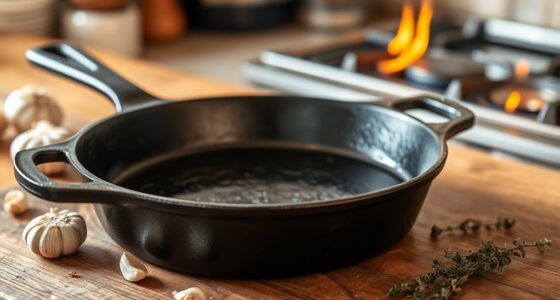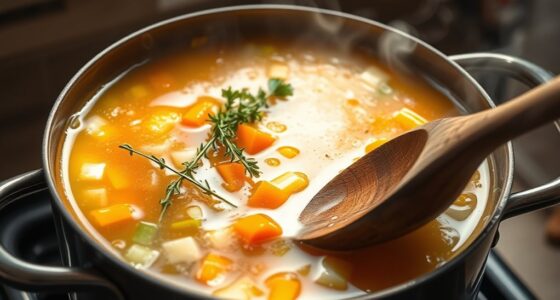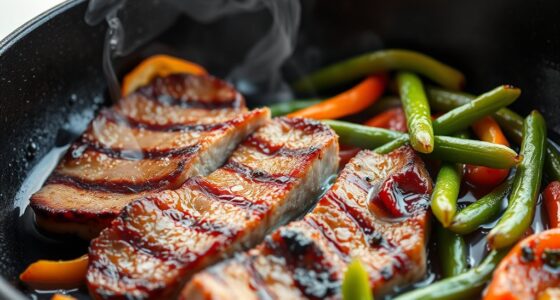To layer flavors in a one-pot dish, start by sautéing aromatics like onions, garlic, and spices to release their essential oils. Next, brown your proteins to add depth, then deglaze the pot with broth or wine to lift caramelized bits. Add ingredients in stages, starting with those needing more time, and incorporate quicker-cooking vegetables later. Adjust seasonings as you go for a balanced taste. Keep exploring these techniques to master flavorful one-pot meals.
Key Takeaways
- Sauté aromatics like onions and garlic first to release their essential oils and build a flavor base.
- Brown proteins before adding liquids to deepen taste and create savory caramelized bits.
- Deglaze the pot with broth or wine to lift flavorful browned bits and enrich the dish.
- Add ingredients in stages, starting with those needing longer cooking, then quick-cooking items later.
- Taste and adjust seasonings throughout cooking to balance and enhance layered flavors.

Have you ever wished for a way to make a delicious meal with minimal cleanup? One-pot cooking is your answer. It’s a straightforward approach that combines simplicity with flavor, allowing you to craft hearty dishes without juggling multiple pots and pans. The secret lies in layering flavors carefully and utilizing smart cooking techniques. Plus, you can make ingredient substitutions easily, adapting recipes to what you have on hand or to suit your taste.
When you’re starting a one-pot meal, think about how to build flavor from the bottom up. Begin by sautéing aromatics like onions, garlic, or spices directly in the pot. This step not only releases their essential oils but also forms a flavorful base for the entire dish. Once these ingredients are softened and fragrant, you can add your proteins, vegetables, and liquids. Using cooking techniques such as browning meat before simmering enhances depth, while deglazing the pot with a splash of broth or wine lifts caramelized bits, adding richness. These methods are crucial for layering flavors effectively in a single vessel.
Ingredient substitutions are a great way to customize your dish and keep it interesting. For example, if a recipe calls for chicken but you’re out, you can easily swap in turkey, firm tofu, or chickpeas. If fresh herbs aren’t available, dried herbs or even a squeeze of lemon can brighten up the dish. Similarly, if you don’t have a specific vegetable, substitute with what’s in your fridge—frozen peas, bell peppers, or zucchini all work well. The key is understanding how different ingredients behave during cooking, which helps you make smart substitutions without sacrificing flavor or texture.
Mastering cooking techniques in one-pot meals is all about timing and heat control. Add ingredients in stages, starting with those that take longer to cook, like root vegetables or tougher meats, and then incorporating quicker-cooking items later on. Keep an eye on moisture levels, as well—adding too much liquid can turn your dish soupy, while too little might cause sticking or burning. Stirring occasionally and adjusting heat as needed ensures everything cooks evenly. Using a lid at strategic moments will trap steam, tenderize ingredients, and meld flavors together.
With practice, you’ll get a feel for when to layer ingredients, how to adjust seasoning, and how to substitute ingredients confidently. One-pot cooking isn’t just about convenience; it’s a technique that rewards your attention to detail and understanding of flavors. In the end, you’ll enjoy a satisfying, flavorful meal, with the added bonus of easy cleanup. That’s the beauty of mastering one-pot dishes—less mess, more flavor, and a quick, delicious meal every time.
Frequently Asked Questions
Can I Use a Slow Cooker for Layered One-Pot Recipes?
Yes, you can use a slow cooker for layered one-pot recipes. Its versatility allows you to implement layered cooking techniques by adding ingredients in stages, starting with those that need longer cooking times. Just be sure to layer ingredients appropriately, placing denser items at the bottom and more delicate ones on top. This way, you maximize the slow cooker’s versatility and develop rich, layered flavors in your dish.
What Are the Best Beginner-Friendly One-Pot Dishes?
These beginner-friendly one-pot dishes are so simple, they practically cook themselves! Start with easy layering techniques like sautéing aromatics first, then adding proteins and vegetables with complementary flavor combinations. Dishes like chili, jambalaya, or chicken and rice are perfect, as they let you build flavors step-by-step in one pot. You’ll master layering techniques quickly and enjoy delicious, hassle-free meals that impress everyone at the table.
How Do I Prevent Ingredients From Sticking or Burning?
To prevent ingredients from sticking or burning, start with proper ingredient preparation and use seasoning techniques like coating ingredients lightly with oil. Stir frequently and add ingredients gradually, giving each enough time to cook evenly. Keep the heat at a moderate level, and consider deglazing the pot with a splash of liquid if anything sticks. These steps help layer flavors while ensuring your dish cooks evenly without burning.
Are There Any Dietary Restrictions Suitable for One-Pot Cooking?
You can totally make one-pot meals fit any dietary restriction! Think of gluten-free options like rice, quinoa, or gluten-free pasta, and vegan substitutions such as tofu, tempeh, or plant-based milks. Just swap out ingredients with your favorites, and you’re ready to roll. It’s like creating a personalized culinary masterpiece that’s safe, delicious, and tailored just for you — your taste buds will thank you for the variety!
How Do I Adjust Cooking Times for Different Ingredients?
You should adjust cooking times based on ingredient prep and cook time estimation. Start by chopping ingredients uniformly for even cooking. Add ingredients with longer cook times first, then shorter ones later. Keep an eye on the pot and stir frequently to prevent over or undercooking. Use your judgment and taste test as you go, adjusting the heat and timing to make sure each ingredient is perfectly cooked.
Conclusion
Cooking in one pot isn’t just convenient; it saves you time and reduces cleanup, letting you enjoy more of your meal and less of the mess. Did you know that home cooks who use one-pot recipes report a 30% reduction in meal prep time? So, next time you want a flavorful, stress-free dinner, remember that layering ingredients in a single pot not only simplifies your life but also delivers delicious results with less fuss.









